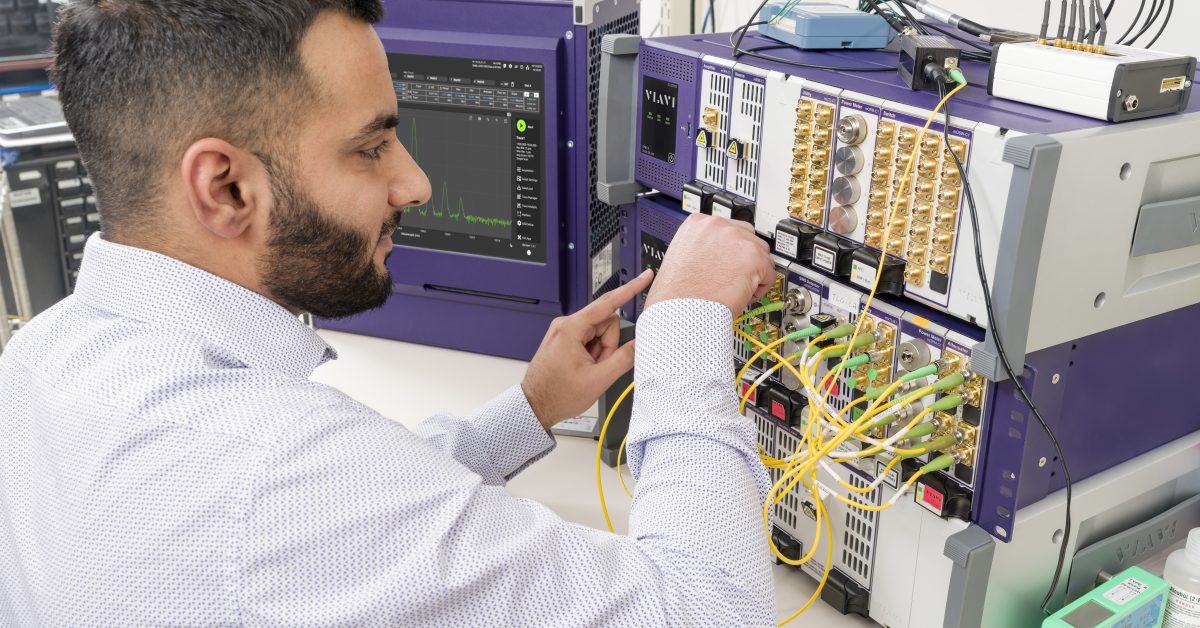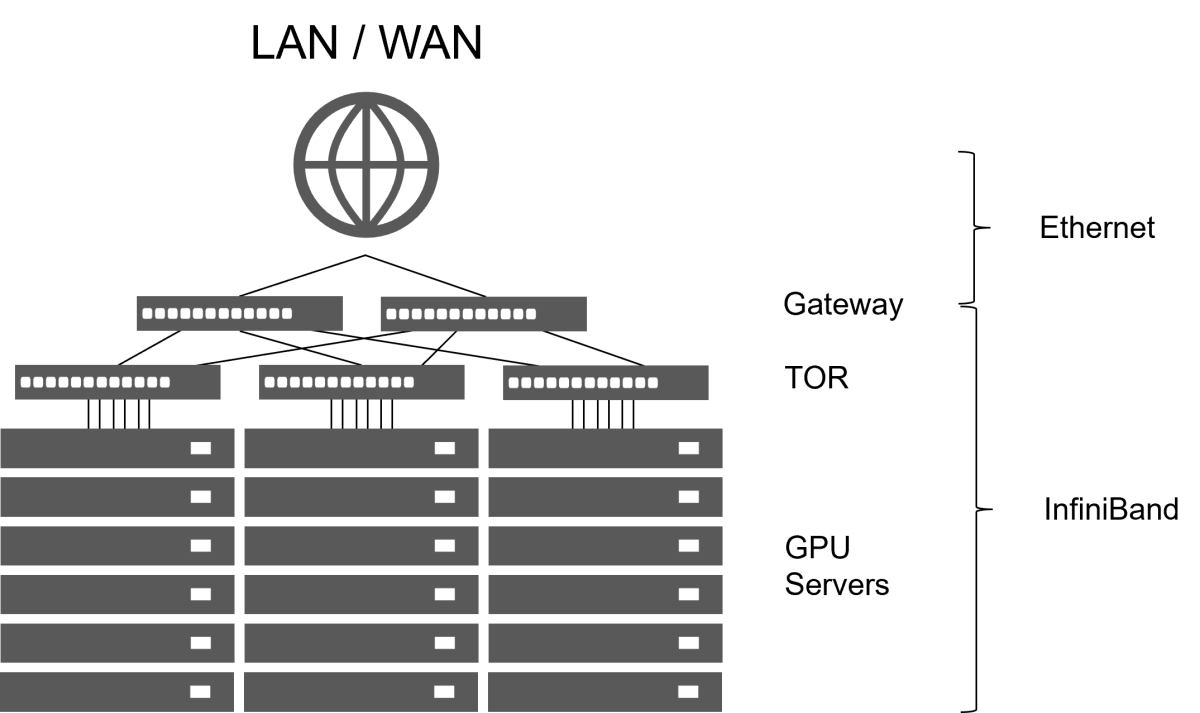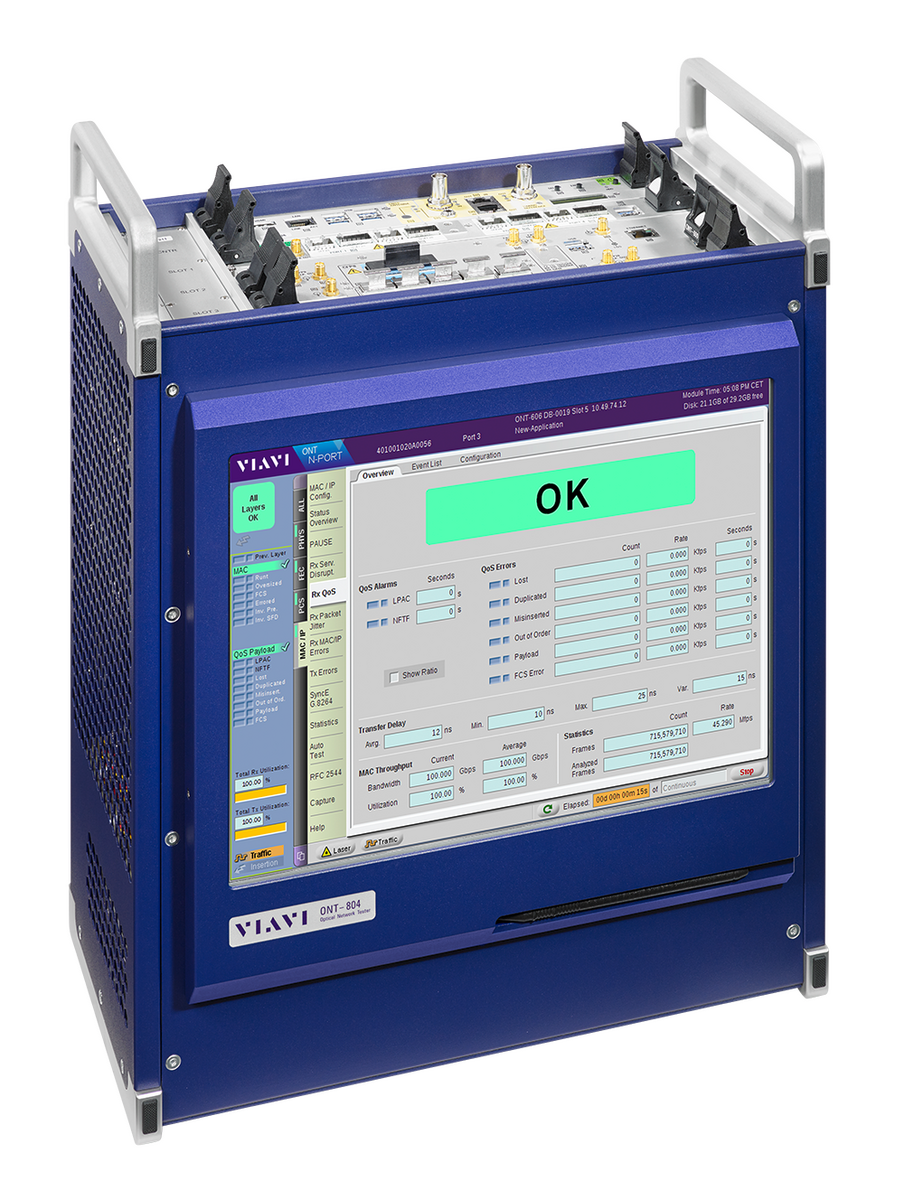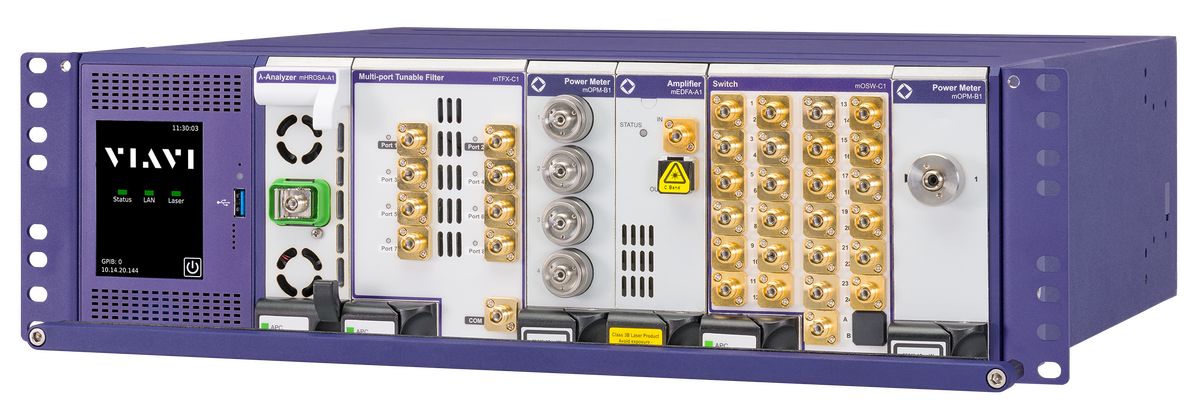AI/ML Data Demands Drives 800G Ecosystem Growth

The rapid advancement of artificial intelligence (AI) and machine learning (ML) applications necessitates unparalleled data transmission and processing speeds. As datasets grow exponentially, the demand for faster transmission solutions escalates, leading to the development of 800G and 2x400G transceiver technologies to overcome existing bottlenecks, with forecasts of 1.6Tb on the horizon. However, transitioning to these technologies poses challenges.

Both DR4 and DR8 formats are pivotal for short-reach connections, utilizing parallel lanes for transmission. The MPO connector is crucial, offering high-density and multi-fiber connectivity, albeit with challenges such as polarity management and susceptibility to contamination. In addition, there is a protocol choice between Ethernet or InfiniBand, with optimal selection dependent on the use case and factors such as speed, latency and reliability.
Testing 800G transceivers during the development, manufacture and deployment is critical to ensure the reliability and performance of these technologies for next-generation AI networks. VIAVI platforms like the ONT and MAP-300 offer comprehensive testing capabilities that ensure performance, reliability and compliance. In addition, the VIAVI MPO testing portfolio ensures optimal performance of MPO connectors.
DR Formats
DR4 and DR8 are optical module physical layer formats specified by the IEEE 802.3 standard for data centers and cloud computing environments. Specifically engineered for short-reach connections over single-mode fiber (SMF), they serve as vital components facilitating high-speed interconnects between GPU modules.
 DR4 utilizes four parallel lanes for data transmission, resulting in a 400G link when each lane carries a 100G signal. Optimized for distances up to 500 meters, DR4 modules are commonly deployed in QSFP-DD or OSFP form factors. Similarly, DR8 operates with eight lanes, each carrying a 100G signal, resulting in an 800G interface. Optimized for short-reach connections over single-mode ribbon fiber, DR8 modules offer comparable reach to DR4. They are also available in QSFP-DD or OSFP form factors.
DR4 utilizes four parallel lanes for data transmission, resulting in a 400G link when each lane carries a 100G signal. Optimized for distances up to 500 meters, DR4 modules are commonly deployed in QSFP-DD or OSFP form factors. Similarly, DR8 operates with eight lanes, each carrying a 100G signal, resulting in an 800G interface. Optimized for short-reach connections over single-mode ribbon fiber, DR8 modules offer comparable reach to DR4. They are also available in QSFP-DD or OSFP form factors.
Both DR4 and DR8 formats play pivotal roles in facilitating high-speed, low-latency communication infrastructure. They offer the necessary bandwidth and scalability to address the escalating demands of data-intensive applications such as AI/ML, cloud computing and big data analytics.
The MPO Connector
 The multifiber push on (MPO) connector serves as the primary optical connector for both DR4 and DR8 formats. It is characterized by its high-density, multi-fiber design that enables rapid and efficient connections for high-bandwidth data transmission. This is particularly valuable in data center environments where space is at a premium.
The multifiber push on (MPO) connector serves as the primary optical connector for both DR4 and DR8 formats. It is characterized by its high-density, multi-fiber design that enables rapid and efficient connections for high-bandwidth data transmission. This is particularly valuable in data center environments where space is at a premium.
With its ability to accommodate up to 16 fibers, the MPO-16 connector aligns well with the duplex nature of DR8’s 8 transmit and 8 receive channels. In instances like the dual MPO OSFP module for 2x400G applications, each MPO connector facilitates the transmission of one of the 400G channels, typically utilizing two MPO-12 connectors.
Despite their advantages, MPO connectors present challenges such as complex polarity management, susceptibility to contamination requiring meticulous cleaning, as well as difficulties in inspection due to mechanical constraints in the transceiver. Achieving optimal alignment and physical contact crucial for maintaining signal integrity necessitates proper handling, specialized testing tools and thorough planning.
Ethernet, InfiniBand, or Both?
The selection between Ethernet and InfiniBand hinges on the specific needs of the application, namely speed, latency, reliability and scalability. Latency, particularly crucial in real-time analytics and autonomous systems within AI applications, underscores the significance of this choice.
Ethernet stands as the predominant networking technology in use today, distinguished by its adaptability and compatibility across a wide array of network devices and applications. In contrast, InfiniBand is tailored for high-performance computing (HPC) and enterprise data centers, prioritizing low latency and high throughput. It finds extensive application in environments requiring robust data processing capabilities and real-time data analytics.
Numerous new 800G pluggable optical interfaces accommodate both Ethernet and InfiniBand protocols, enhancing flexibility and interoperability in high-speed networking scenarios.
Testing
 Testing 800G transceivers requires rigorous procedures to ensure compliance with industry standards for performance, reliability and interoperability. The VIAVI ONT (Optical Network Tester) for 800G is a comprehensive solution designed to validate high-speed network devices and systems, including 800Gs transceivers. This advanced platform offers full line-rate traffic generation and analysis capabilities, enabling thorough testing of components, modules and systems for performance, error rates and adherence to standards. Supporting a range of protocols essential for next-gen networks, the VIAVI ONT for 800G is vital for developers and manufacturers striving to deliver reliable, high-performance 800G solutions.
Testing 800G transceivers requires rigorous procedures to ensure compliance with industry standards for performance, reliability and interoperability. The VIAVI ONT (Optical Network Tester) for 800G is a comprehensive solution designed to validate high-speed network devices and systems, including 800Gs transceivers. This advanced platform offers full line-rate traffic generation and analysis capabilities, enabling thorough testing of components, modules and systems for performance, error rates and adherence to standards. Supporting a range of protocols essential for next-gen networks, the VIAVI ONT for 800G is vital for developers and manufacturers striving to deliver reliable, high-performance 800G solutions.
 The VIAVI MAP-300 Photonic Test and Measurement System is a versatile platform designed for testing transceivers and optical connectivity in lab and manufacturing. It accommodates various test modules catering to different parameters and stages of transceiver testing. The system enables essential measurements such as optical power levels, insertion loss and spectral analysis. Signal conditioning modules like variable attenuators are used in conjunction with signal integrity and bit error rate testing. Automated testing routines and optical switching enhance efficiency in high-volume production environments, generating reports on test results for quality control. Thanks to its modular feature, users can adapt to specific design and test challenges.
The VIAVI MAP-300 Photonic Test and Measurement System is a versatile platform designed for testing transceivers and optical connectivity in lab and manufacturing. It accommodates various test modules catering to different parameters and stages of transceiver testing. The system enables essential measurements such as optical power levels, insertion loss and spectral analysis. Signal conditioning modules like variable attenuators are used in conjunction with signal integrity and bit error rate testing. Automated testing routines and optical switching enhance efficiency in high-volume production environments, generating reports on test results for quality control. Thanks to its modular feature, users can adapt to specific design and test challenges.
 VIAVI MPO testing solutions support manufacturing and field deployment, and ensure optimal performance and reliability of MPO connectors. These solutions cover critical aspects such as end-face inspection, optical loss testing, polarity verification and cleanliness assessment. In addition, they ensure compliance with industry standards and reliable operation in diverse network environments. With automated testing capabilities and detailed reporting features, VIAVI MPO testing solutions facilitate efficient and accurate assessment, contributing to the integrity and efficiency of deployments. All VIAVI testing solutions are designed to support automated procedures, which are crucial for maintaining consistent testing conditions and result in high-volume production environments.
VIAVI MPO testing solutions support manufacturing and field deployment, and ensure optimal performance and reliability of MPO connectors. These solutions cover critical aspects such as end-face inspection, optical loss testing, polarity verification and cleanliness assessment. In addition, they ensure compliance with industry standards and reliable operation in diverse network environments. With automated testing capabilities and detailed reporting features, VIAVI MPO testing solutions facilitate efficient and accurate assessment, contributing to the integrity and efficiency of deployments. All VIAVI testing solutions are designed to support automated procedures, which are crucial for maintaining consistent testing conditions and result in high-volume production environments.
Conclusion
Formats like DR8 address the exponential growth in data traffic and the need for higher-speed network connections in data centers. As AI and ML workloads drive ever-increasing demand for bandwidth, technologies like 2x400GbE and 800GE transceiver modules in the DR8 format play a crucial role in enabling efficient, high-capacity networking infrastructure.
Testing these transceivers in production is a critical step in ensuring that these components can deliver the required performance and reliability in next-generation networks. VIAVI offers comprehensive testing tools and methodologies to address the unique challenges posed by high-speed data transmission, enabling manufacturers and network operators to thoroughly evaluate and certify their 800G technologies before and during deployment.
See our solutions in action and schedule a meeting with our experts at VIAVI’s booth 2013 at OFC 2024 from March 26-28 at the San Diego Convention Center. In addition, VIAVI will join a panel of industry experts to discuss how AI influences optical industry growth on Wednesday, March 27 from 2-3 PM PST at the San Diego Convention Center, Room #4.
We look forward to seeing you at OFC 2024!



